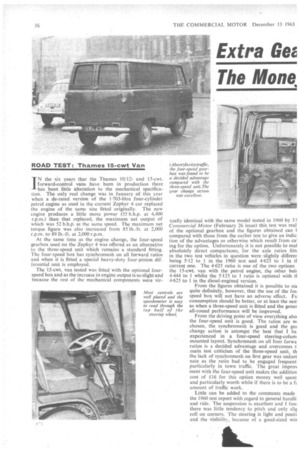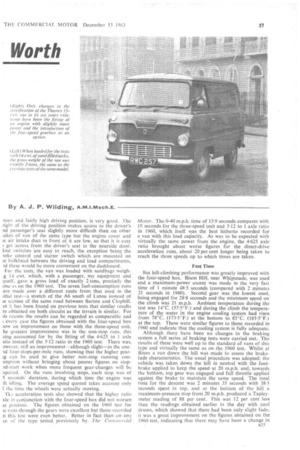Extra Gez Worth The Ilionet
Page 58

Page 59

Page 60

If you've noticed an error in this article please click here to report it so we can fix it.
IN the six years that the Thames 10/12and 15-cwt. forward-control vans have been in production there has been little alteration to the mechanical specification. The only real change was in January of this year when a de-rated version of the 1-703-litre four-cylinder petrol engine as used in the current Zephyr 4 car replaced the engine of the same size fitted originally. The new engine produces a little more . power (55 b.h.p. at 4,400 r.p.m.) than that replaced, the maximum net output of which was 52 b.h.p. at the same speed. The maximum net torque figure was also increased from 85 lb.-ft. at 2,000 r.p.m. to 89 lb.-ft. at 2,000 r.p.m.
At the same time as the engine change, the four-speed gearbox used on the Zephyr 4 was offered as an alternative to the three-speed unit which remains a standard fitting. The four-speed box has synchromesh on all forward ratios and when it is fitted a special heavy-duty four-pinion differential unit is employed.
The 15-cwt. van tested was fitted with the optional fourspeed box and as the increase in engine output is so slight and because the rest of the mechanical components were vir
tually identical with the same model tested in 1960 by 74 Commercial Motor (February 26 issue) this test was real of the optional gearbox and the figures obtained can t compared with those from the earlier test to give an indic. tion of the advantages or otherwise which result from cal Mg for the option. Unfortunately it is not possible to mai absolutely direct comparisons, for the axle ratios fittx in the two test vehicles in question were slightly differer being 5.12 to 1 in the 1960 test and 4-625 to 1 in ti current one. The 4.625 ratio is one of the two options the 15-cwt. van with the petrol engine, the other beir 4.444 to I whilst the 5-125 to I ratio is optional with ti 4.625 to 1 in the diesel-engined version.
From the figures obtained it is possible to sta quite definitely, however, that the use of the fou speed box will not have an adverse effect. Fu consumption should be better, or at least the sam as when a three-speed unit is fitted and the gener all-round performance will be improved.
From the driving point of view everything abo the four-speed unit is good. The ratios are chosen, the synchromesh is good and the gea change action is amongst the best that I ha experienced in a four-speed steering-colum mounted layout. Synchromesh on all four forwa ratios is a decided advantage and overcomes ti main test criticism of the three-speed unit, th the lack of synchromesh on first gear was unfort nate as the ratio had to be engaged frequent' particularly in town traffic. The great improN merit with the four-speed unit makes the addition cost of f16 for this option money well spent and particularly worth while if there is to be a f2 amount of traffic work.
Little can be added to the comments made the 1960 test report with regard to general handlil and ride. The suspension is excellent and I foul there was little tendency to pitch and only slig roll on corners. The steering is light and positi and the visibilit. because of a good-sized win :teen and fairly high driving position, is very good. The 2tght of the driving position makes access to the driver's ad passenger's seat slightly more difficult than on other Lakes of van of the same type but the engine cover and ie air intake duct in front of it are low, so that it is easy o get across from the driver's seat to the nearside door. lost switches are easy, .to reach, the exception being the ioke control and starter switch which are mounted on le bulkhead between the driving and load compartments, ad these would be more convenient on the dashboard.
For the tests, the van was loaded with sandbags weigh!g 14 cwt. which, with a passenger, my equipment and Lysell, gave a gross load of exactly 2 tons, precisely the ,me as on the 1960 test. The seven fuel-consumption runs ere made over a different route from that used in the 'Mal test—a stretch of the A6 south of Luton instead of le section of the same road between Barton and Clophill. ut ii has been found on previous tests that similar results re obtained on both circuits as the terrain is similar. For is reason the results can be regarded as comparable and , every case the figures obtained with the four-speed box low an improvement on those with the three-speed unit. he greatest improvement was in the non-stop runs, this eing accounted for by the fitting of the 4.625 to 1 axle ilia instead of the 5-12 ratio in the 1960 test. There was, Dwever, still an improvement—although slight—in the mead four-stops-per-mile runs, showing that the higher gearig can be used to give better non-stop running conImplion without bringing about poorer figures on stoprid-start work when more frequent gear-changes will be :quired. On the runs involving stops, each stop was of 5 seconds duration, during which time the engine was ft idling. The average speed quoted takes account only E the time the wheels were actually moving.
acceleration tests also showed that the higher ratio xle in conjunction with the four-speed box did not worsen te position. The figures obtained on the 1960 test for le runs through the gears were excellent but those recorded n this test were even better. Better in fact than on any in of the type tested previously by The Commercial Motor. The 0-40 m.p.h. time of 15-9 seconds compares with 18 seconds for the three-speed unit and 5-12 to 1 axle ratio in 1960, which itself was the best hitherto recorded for a van with this load capacity. As was to be expected with virtually the same power from the engine, the 4-625 axle ratio brought about worse figures for the direct-drive acceleration runs, about 20 per cent longer being taken to reach the three speeds up to which times are taken.
But hill-climbing performance was greatly improved with the four-speed box. Bison Hill, near Whipsnade, was used and a maximum-power ascent was made in the very fast time of 1 minute 48-5 seconds (compared, with 2 minutes 21 seconds in 1960). Second gear was the lowest used, being engaged for 28-8 seconds andthe minimum speed on the climb was 21 m.p.h.. Ambient temperature during the test was 14°C. (57.5°F.) and during the climb the temperature of the water in the engine cooling ystem had risen from 78°C. (173-5°F.) at the bottom to 85°C. (185-5°F.) at the top. These were similar figures to those recorded in 1960 and indicate that the cooling system is fully adequate. Although there have been no changes in the braking system a full series of braking tests were carried .out..The results of these were well up to the standard of vans of this type and virtually the same as on the 1960 test. Whilst at Bison a run downthe. hill vvak made to assess the brakefade characteristics. The usual procedure was 'adopted; the vehicle was taken .down the hill in neutral with the footbrake applied to keep the speed-at 20 m.p.h. and; towards the bottom, top gear was engaged and full throttle applied against the brake to maintain the same speed. The total time for the descent was. 2 minutes 35 seconds with 38-5 seconds spent in top. and at the bottom of the _hill a maximum-pressure s-top from 20 m.p.h. produced a Tapleymeter reading of 88 per cent. This was 12 per cent less than the readings obtained earlier in the day, with cool drums, which showed that there had been only slight fade; it was a great improvement on the figures obtained-on the 1960 test, indicating that there-may have been a change in
the material used for the linings in the period since then.
Bison Hill was also used for stop and restart tests. The steepest section, which has a gradient of 1 in 6.5, was used for these and easy restarts were made in bottom gear when facing uphill and in reverse gear when facing downhill. In both conditions the handbrake held the vehicle comfortably and it was almost possible to take off when facing up the hill in second gear. .
No high-speed fuel consumption run was carried out because of road works on the M1 motorway which could have made figures unreliable, and there was in any case a blustery cross-wind which made control difficult at high speeds. But the motorway was used to check the accuracy of the speedometer, which was found to be 3 per cent fast tO6
at 30 m.p.h. and 5 per cent fast at 60 m.p.h. Maximt speeds in the gears were also checked on the motorw and these were found to be 27 m.p.h. in first, 45 m.p.h. second, 55 m.p.h. in third and 75 m.p.h. in top gear.
As tested, the Thames 15-cwt petrol-engined van has basic price of £479. Painting in a choice of seven colot adds £12 10s. whilst a regular group of optional extt fitted (comprising a passenger seat, an extra sun visor,• foot rail in front of the seat and, for some unknown mast quarter rear bumpers) add £11 to the price; the heater a demister cost £12 and the four-speed gearbox, as stat earlier, adds £16. This makes the total price of tho van tested, £518 (E530 10s. painted) and another option r fitted is a side loading door which would add £14.




















































































































